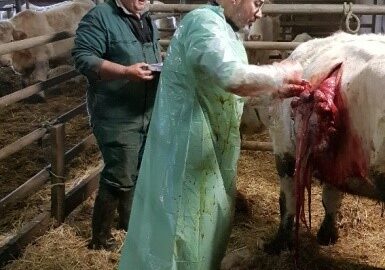Les déchirures utérines chez la vache : traitement chirurgical après renversement provoqué de l’organe

Auteurs
Résumé
Les techniques habituelles de réparation chirurgicale pour traiter les plaies pénétrantes de l’utérus n’apportent pas toujours satisfaction, entre difficultés d’accès à la plaie et état de choc de l’animal. Le praticien peut alors essayer de provoquer le prolapsus utérin afin de faciliter l’accès de la lésion. Pour ce faire, il faut passer le bras dans la cavité abdominale de la vache à travers le trou existant pour invaginer la corne, tirer sur les cotylédons et bénéficier d’une contraction abdominale de l’animal. Une fois extériorisé, l’utérus peut être recousu efficacement par un double surjet puis réintroduit selon des méthodes classiques. La préparation de l’intervention est primordiale et la main-d’œuvre doit être suffisante. Des complications existent mais elles peuvent être gérées pour la plupart si le praticien est ordonné et consciencieux.
Abstract
The techniques usually used to surgically repair uterine tears are not always successful, due to difficulties associated with appropriate access to the wound and the shock status of the animal. The practitioner can try to induce a uterine prolapse in order to gain access to the wound. To do this, the practitioner must reach into the abdominal cavity through the existing hole in order to invaginate the uterine horn by pulling on the cotyledons while taking advantage of the natural abdominal contractions of the cow. Once the uterus has be exteriorised it can be sown-up using a double continuous suture then reintroduced into its correct position using classical techniques. The preparation of the operation is primordial and sufficient help must be available. Complications exist but they can normally be managed if the practitioner is organised and conscientious.
D'autres articles
Découvrez aussi nos formations
01 décembre 2025
5 jours
Bovin laitier · Bovin viande · Bovins


